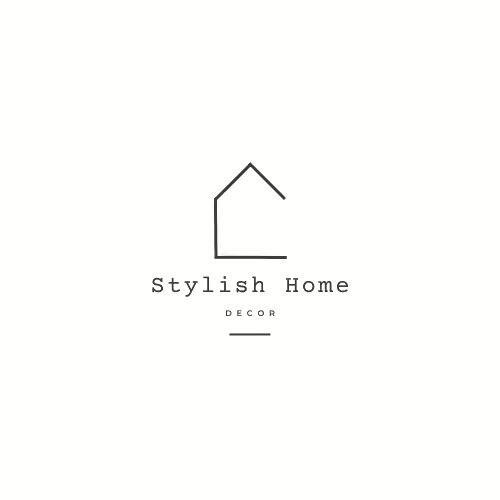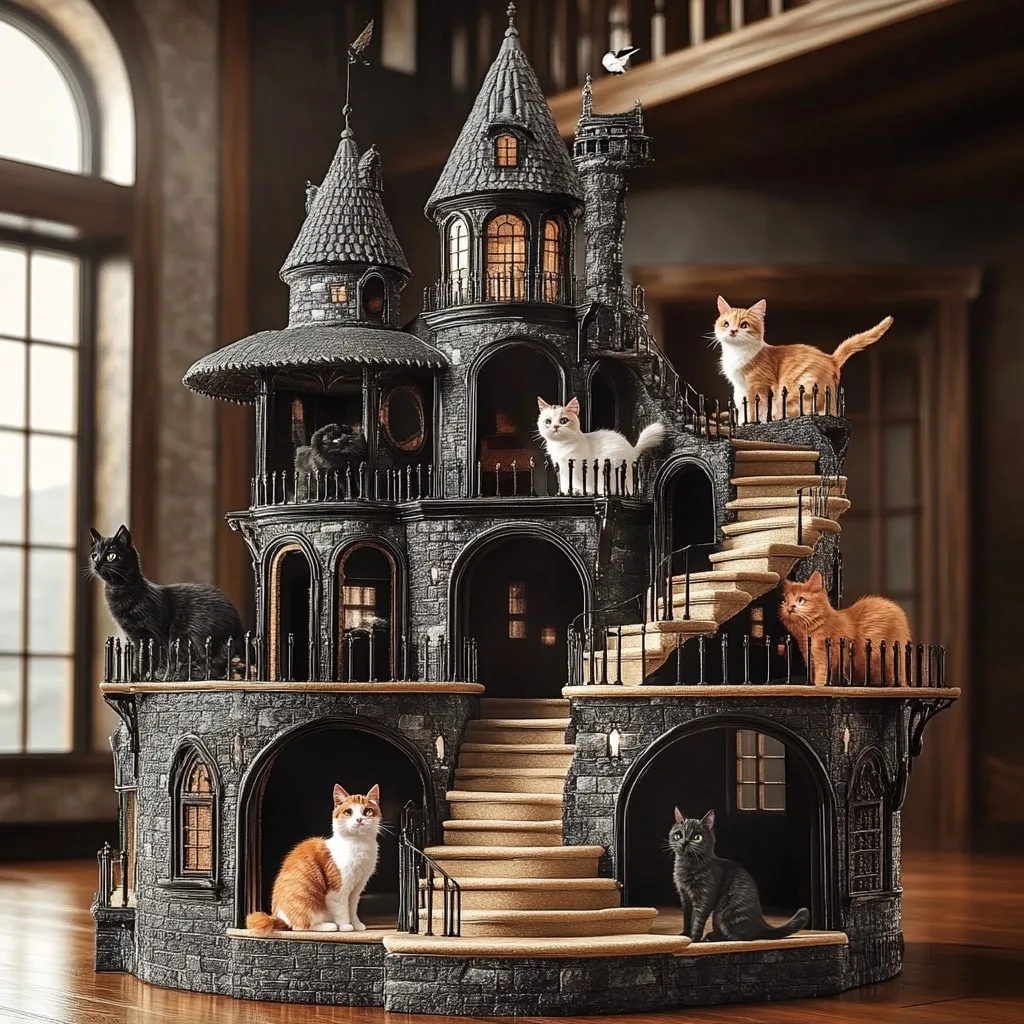The intersection of pet care and interior design has reached new heights with the rising popularity of Gothic mansion-shaped cat houses. These elaborate feline dwellings are far more than simple pet furniture—they’re architectural statements that celebrate both the majesty of your cat and the dramatic aesthetic of Gothic design. For cat owners who appreciate the darker, more romantic elements of historical architecture, these miniature mansions offer a way to indulge their pets while adding a conversation piece to their home decor.
Gothic mansion-shaped cat houses draw inspiration from the grand structures of the 18th and 19th centuries, featuring dramatic spires, pointed arches, intricate detailing, and an overall sense of dramatic elegance that seems perfectly suited to the regal nature of domestic cats. While traditional cat trees and scratching posts serve practical purposes, these Gothic-inspired creations elevate feline furniture to an art form, blending functionality with stunning design elements that complement modern homes.
The Evolution of Pet Furniture Design
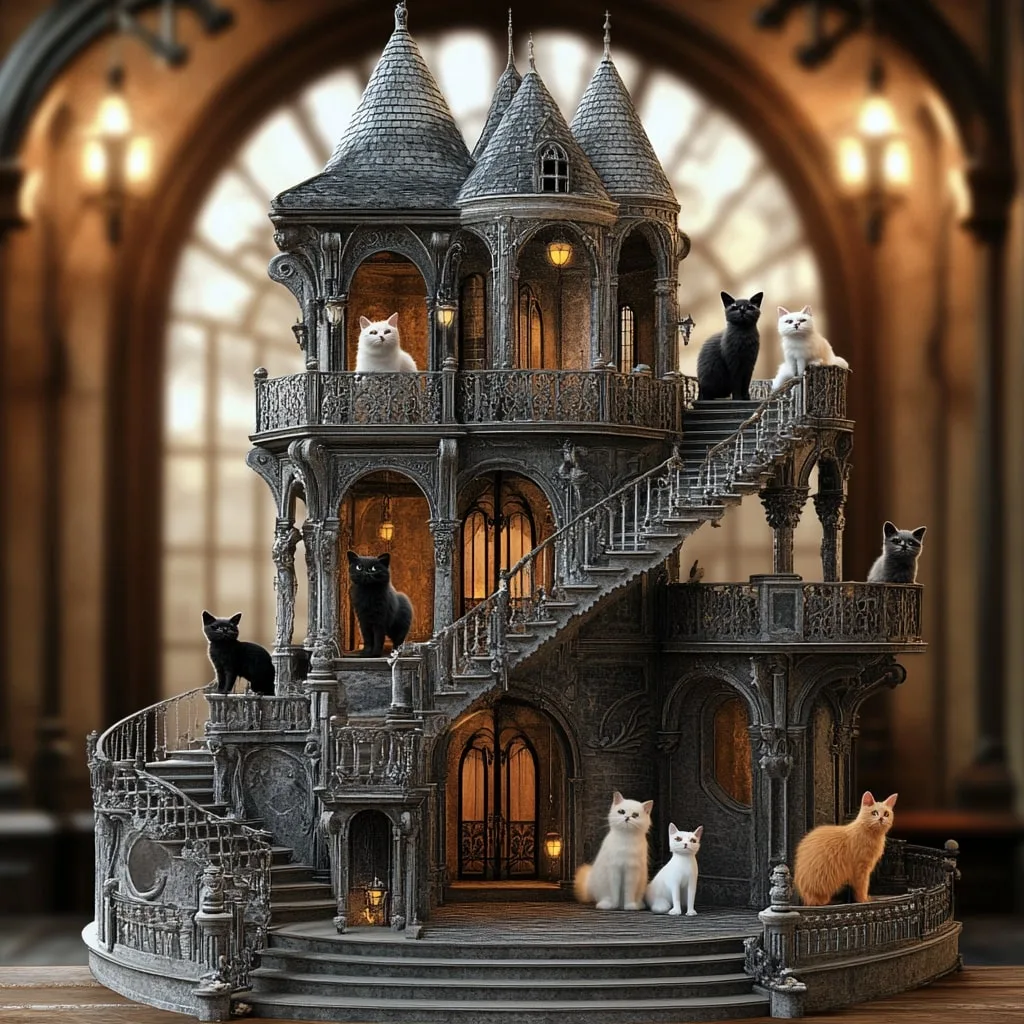
From Practical to Palatial
The journey from simple cat beds to elaborate Gothic mansion-shaped cat houses reflects changing attitudes toward pets and their place in our homes. Historically, pet furniture was purely utilitarian—designed to keep animals off human furniture while providing them with basic comfort. Today’s pet parents, however, increasingly view their companions as family members deserving of luxury and aesthetically pleasing accommodations.
The modern Gothic cat mansion represents the pinnacle of this evolution. These structures acknowledge the cat’s need for vertical territory, hiding spots, and play areas while wrapping these practical elements in a package that complements, rather than detracts from, sophisticated home decor. This transformation mirrors broader trends in pet ownership, where the distinction between human and animal spaces has blurred.
Design Influences and Architectural Elements
Gothic mansion-shaped cat houses draw from several architectural traditions:
- Victorian Gothic Revival: Characterized by pointed arches, steep gables, and ornamental tracery
- High Gothic: Features elaborate spires and flying buttresses
- Gothic Romanticism: Emphasizes dramatic silhouettes and mysterious elements
These influences manifest in cat houses that feature miniature turrets, castellated parapets, decorative finials, and even stained glass window effects. The most elaborate designs include multiple levels connected by staircases or ramps, creating a truly three-dimensional living space for cats to explore.
Benefits of Gothic Mansion-Shaped Cat Houses
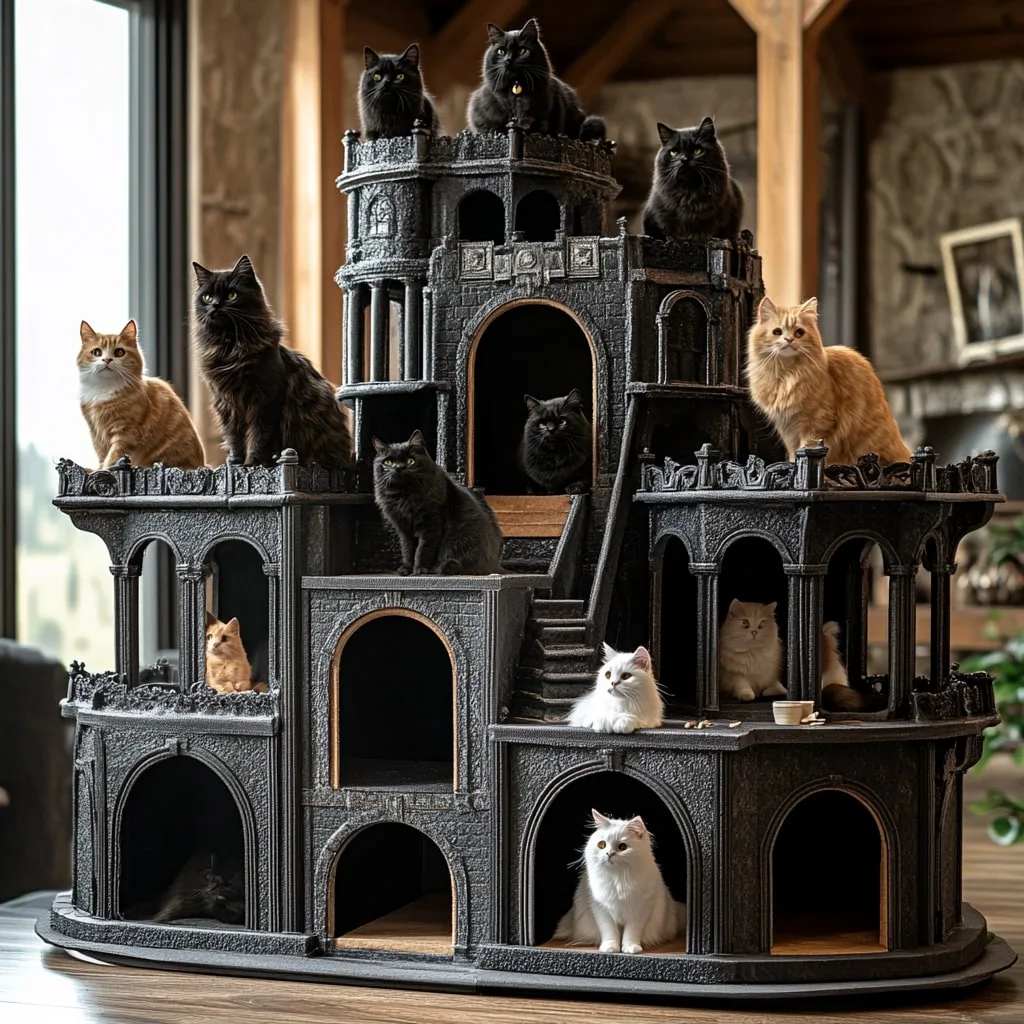
Feline Psychological Wellbeing
Gothic mansion-shaped cat houses do more than simply look impressive—they address several key aspects of feline psychology:
- Territorial Satisfaction: The multi-level design satisfies cats’ natural desire for vertical territory.
- Security: Enclosed spaces and hiding spots fulfill the instinctive need for secure retreats.
- Stimulation: Complex architecture provides mental stimulation through exploration.
- Observation Points: Elevated perches allow cats to survey their domain from safety.
Studies in feline behavior consistently show that environmental enrichment reduces stress-related behaviors and increases overall happiness in indoor cats. The complex structure of Gothic cat mansions provides precisely this type of enrichment, allowing cats to express natural behaviors like climbing, hiding, and perching in an appropriate setting.
Aesthetic Appeal for Human Companions
While the feline benefits are substantial, the visual impact of a Gothic mansion-shaped cat house cannot be understated. These pieces serve as focal points in interior design, creating visual interest and expressing the homeowner’s personality. Unlike conventional pet furniture that often clashes with home decor, Gothic cat mansions can complement existing design elements, particularly in homes that embrace:
- Victorian or vintage-inspired decor
- Dark academia aesthetics
- Maximalist design approaches
- Eclectic or bohemian styles
- Gothic or alternative home themes
For those who appreciate the dramatic and romantic aspects of Gothic architecture, these cat houses provide an opportunity to incorporate these elements without undertaking major renovations.
Popular Styles and Variations
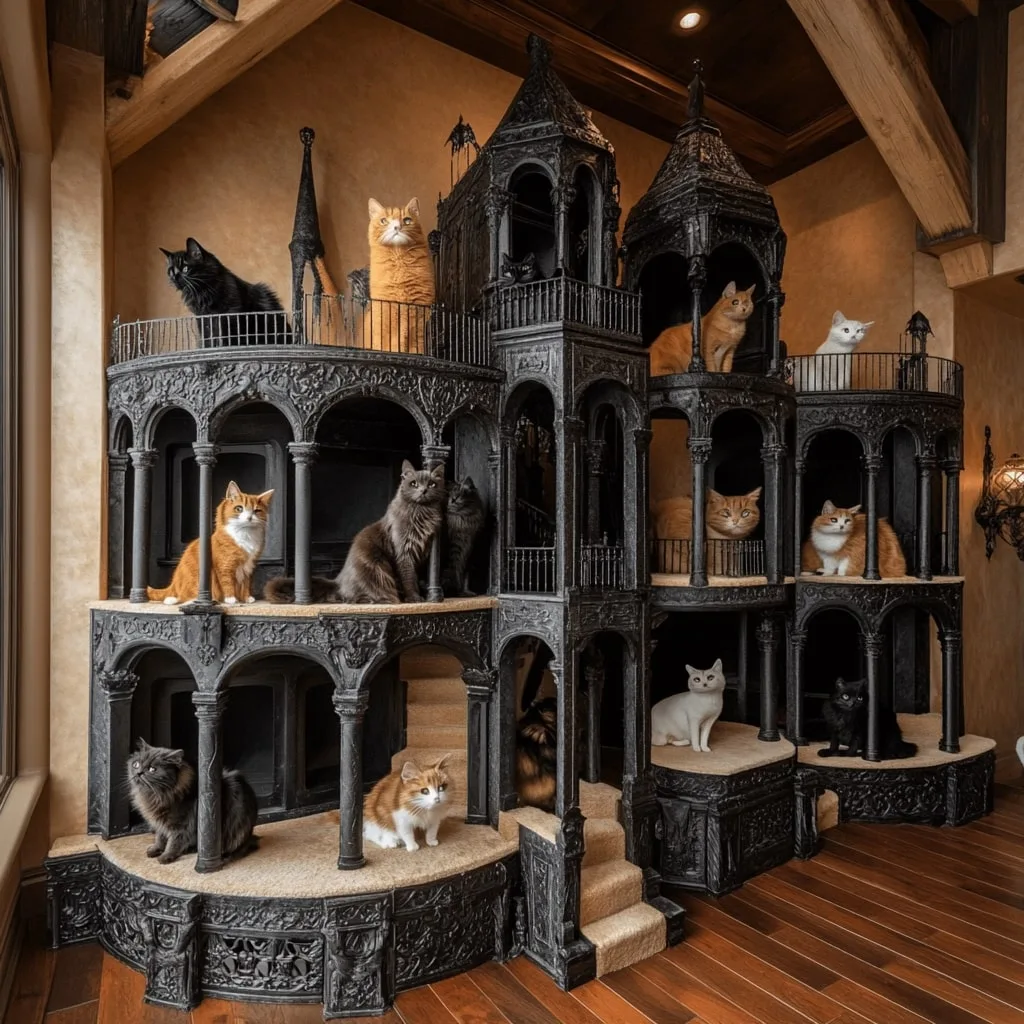
Victorian Gothic Revival Cat Mansions
The Victorian Gothic Revival style represents one of the most popular approaches to Gothic mansion-shaped cat houses. These designs typically feature:
- Ornate woodwork and decorative elements
- Contrasting color schemes, often in dark woods with lighter accents
- Steep, pitched roofs with decorative gables
- Bay windows or alcoves for cat lounging
- Multiple levels connected by decorative staircases
Victorian-inspired cat mansions often incorporate plush elements like velvet cushions or tufted beds, creating a sense of opulence that mirrors the Victorian era’s love of comfort and luxury.
Medieval Castle-Inspired Designs
For a more fortress-like approach, medieval castle-inspired Gothic cat houses offer a bold architectural statement:
- Crenellated tower tops and battlements
- Stonework textures (typically achieved through clever use of materials)
- Drawbridge-style entries and exits
- Circular towers and turrets
- Arched doorways and windows
These designs often use a more monochromatic color palette of grays and blacks to evoke ancient stone, though some incorporate touches of color through “tapestry” elements or “stained glass” features.
Modern Gothic Interpretations
Contemporary designers have begun reimagining Gothic architecture through a modern lens, creating cat mansions that blend traditional Gothic elements with sleek, current design principles:
- Minimalist interpretations of Gothic arches and spires
- Integration of modern materials like acrylic and metal
- Clean lines paired with Gothic silhouettes
- Innovative lighting elements that create dramatic shadows
- Modular components that can be reconfigured
These modern Gothic cat mansions often appeal to design enthusiasts who appreciate historical references without wanting a strictly period-accurate piece in their home.
Materials and Construction Considerations
Durability and Safety
When evaluating or building a Gothic mansion-shaped cat house, durability and safety should be primary concerns:
- Sturdy Base: The structure must have a stable, wide base to prevent tipping, especially with multiple cats.
- Non-Toxic Materials: All components should be free from harmful chemicals, with special attention to finishes and adhesives.
- Secure Components: Decorative elements must be firmly attached to prevent cats from pulling them off and potentially ingesting them.
- Structural Integrity: Internal supports should accommodate the weight of multiple cats jumping and climbing.
- Rounded Edges: Despite the Gothic aesthetic’s angular nature, actual edges that cats encounter should be rounded for safety.
Professional-grade Gothic cat mansions typically use furniture-quality materials and construction techniques, ensuring longevity even with enthusiastic feline use.
Sustainable and Eco-Friendly Options
The market for Gothic mansion-shaped cat houses has expanded to include environmentally conscious options:
- Reclaimed wood construction
- Non-toxic, water-based finishes and stains
- Organic fabrics for cushioned areas
- Biodegradable sisal for scratching surfaces
- Recyclable cardboard components for replaceable elements
These eco-friendly options allow environmentally conscious pet owners to provide luxury accommodations for their cats while maintaining their commitment to sustainability.
DIY vs. Professional Gothic Cat Mansions
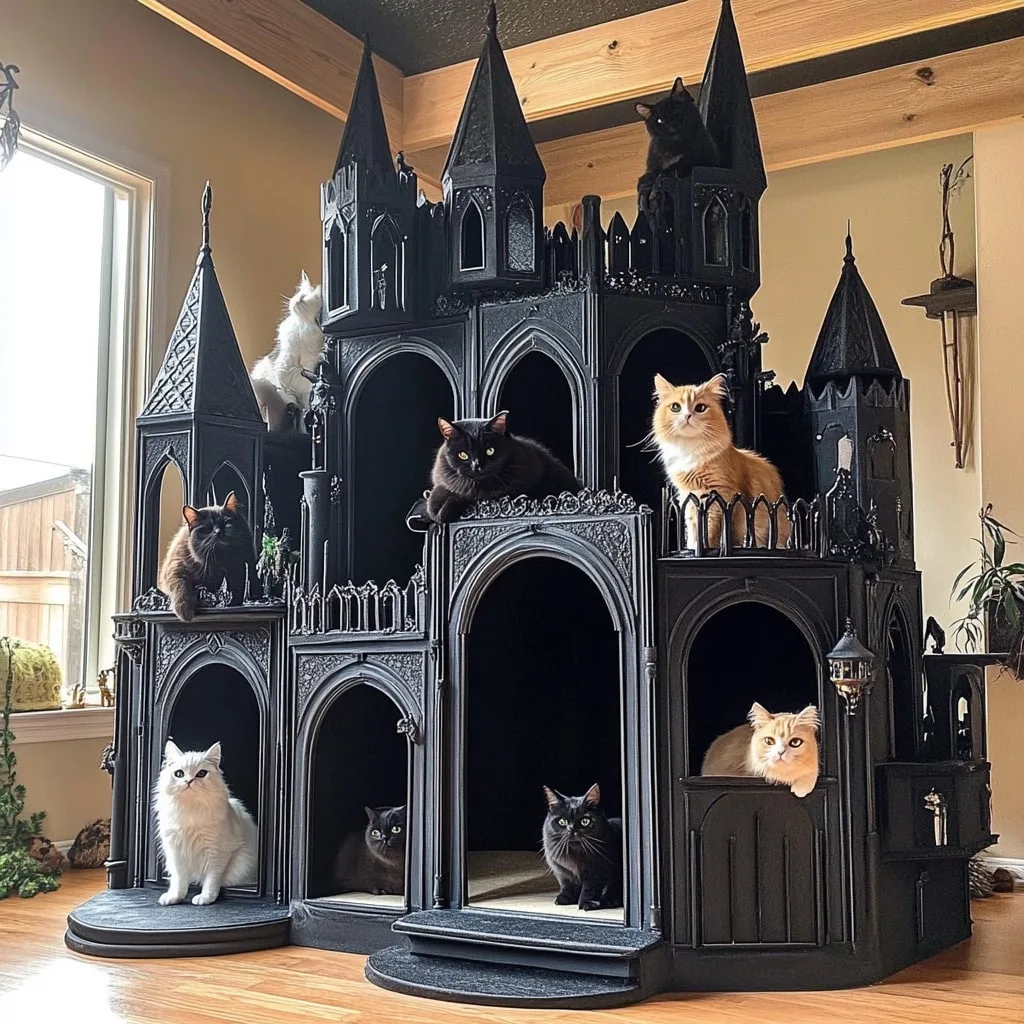
Creating Your Own Gothic Masterpiece
For crafty pet owners, building a Gothic mansion-shaped cat house presents an engaging project that can be customized to specific needs:
Skill Level Assessment
Before beginning a DIY Gothic cat mansion project, honestly assess your:
- Woodworking skills
- Design capabilities
- Available tools
- Time commitment
- Budget constraints
Beginners might start with modifying existing furniture or working from detailed plans, while experienced woodworkers might design completely original structures.
Essential Tools and Materials
A basic DIY Gothic cat mansion project typically requires:
- Jigsaw or band saw for cutting decorative elements
- Drill with various bits
- Sander
- Wood glue and screws
- Medium-density fiberboard (MDF) or plywood
- Carpet remnants or sisal rope
- Decorative finials or ornaments
- Non-toxic paint or stain
More elaborate projects might incorporate CNC-cut components or 3D-printed decorative elements for truly custom designs.
Professional Custom-Built Options
For those seeking the ultimate in Gothic mansion-shaped cat houses, professional pet furniture designers offer bespoke creations:
- Customized to match existing home architecture
- Professionally engineered for safety and durability
- Incorporated smart features like temperature control
- Built with furniture-grade materials and finishes
- Designed to specific dimensional requirements
While significantly more expensive than DIY alternatives, these professional creations often represent true functional art pieces that can become family heirlooms.
Integrating Gothic Cat Mansions into Home Decor
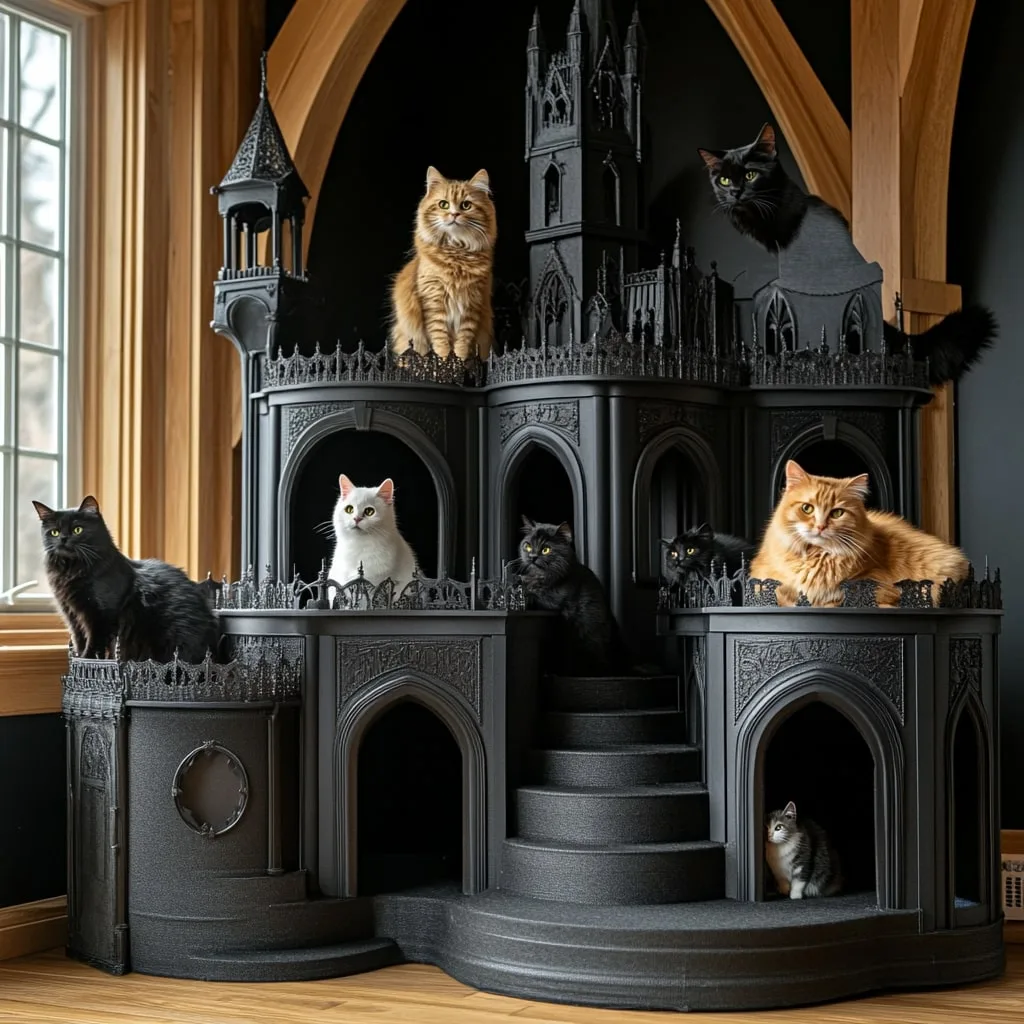
Placement Strategies
The impressive size of many Gothic mansion-shaped cat houses requires thoughtful placement:
- Window Adjacent: Cats appreciate natural light and outdoor views.
- Room Corner: Using corners maximizes floor space while providing the mansion with two walls for stability.
- Room Divider: Larger mansions can function as architectural room dividers in open-plan spaces.
- Focal Point: In rooms with minimal architectural interest, the cat mansion can serve as a deliberate focal point.
- Integrated with Shelving: Some designs incorporate human storage and display areas alongside cat spaces.
The best placement considers both human traffic patterns and the cat’s preference for observation points and quiet retreats.
Complementary Design Elements
To create cohesion between a Gothic mansion-shaped cat house and existing decor, consider:
- Color Coordination: Choose finishes that complement your color scheme.
- Material Matching: Align wood tones or metal finishes with existing furniture.
- Textile Continuity: Use similar fabrics for cat bedding and human furnishings.
- Proportional Scale: Select a size appropriate to your room dimensions.
- Lighting Enhancement: Use strategic lighting to highlight architectural details.
These considerations help the cat mansion feel intentional rather than intrusive in your space.
Maintaining Your Gothic Cat Mansion
Cleaning and Hygiene
The elaborate nature of Gothic mansion-shaped cat houses requires specific maintenance approaches:
- Regular Vacuuming: Use attachments to reach crevices and detailed areas.
- Removable Elements: Choose designs with washable cushions and replaceable scratch surfaces.
- Quarterly Deep Cleaning: Schedule seasonal disassembly for thorough cleaning of all components.
- Fabric Protection: Apply pet-safe fabric protectors to upholstered areas.
- Odor Management: Consider built-in carbon filters or zeolite pouches in enclosed areas.
Establishing a regular maintenance schedule prevents the accumulation of fur and dander while prolonging the life of the structure.
Renovation and Refreshing
Over time, even the most durable Gothic cat mansion will need updating:
- Replacing worn scratching surfaces
- Refreshing cushions and bedding
- Touching up paint or finishes
- Adding new features to renew cat interest
- Structural reinforcement if necessary
Many professional manufacturers offer refurbishment services, while DIY builders can use the opportunity to add new architectural elements that reflect their growing skills.
The Future of Gothic Mansion-Shaped Cat Houses

Emerging Trends
The market for luxury pet furniture continues to evolve, with several exciting directions for Gothic mansion-shaped cat houses:
- Smart Integration: Incorporation of automated feeders, temperature control, and interactive elements
- Mixed Materiality: Blending traditional wood with modern materials like carbon fiber or recycled plastics
- Modular Systems: Expandable designs that grow with changing pet needs
- Multi-Species Design: Gothic structures that accommodate both cats and small dogs with separate areas
- Urban Adaptation: Compact versions designed specifically for apartment living
These innovations suggest the Gothic cat mansion trend has staying power beyond mere novelty.
Investment Value
While primarily purchased for their immediate benefits, well-crafted Gothic mansion-shaped cat houses can retain value:
- Artisanal Appreciation: Handcrafted pieces from recognized designers may appreciate over time
- Durability Dividend: Quality construction ensures longevity across multiple cats’ lifespans
- Resale Potential: Unique, high-end pieces maintain stronger resale value than mass-produced alternatives
- Adaptability: Well-designed pieces can be repurposed as display shelving or decorative elements if no longer needed for pets
This potential value retention makes the initial investment more palatable for budget-conscious pet owners.
Why Gothic Mansion-Shaped Cat Houses Represent the Future of Pet Furniture
The Gothic mansion-shaped cat house stands at the intersection of practical pet care, interior design, and architectural appreciation. Far from being merely an indulgence, these elaborate structures address genuine feline needs while elevating the aesthetic of the homes they inhabit. They represent a philosophy that pets deserve environments as thoughtfully designed as those we create for ourselves.
As our understanding of animal psychology deepens and our relationships with our pets continue to evolve, we can expect to see further refinement of these specialized living spaces. The Gothic cat mansion is more than a trend—it’s a testament to our commitment to providing enriched environments for our feline companions and our desire to surround ourselves with objects of beauty and meaning.
Whether purchased from a specialized maker or lovingly crafted as a DIY project, a Gothic mansion-shaped cat house makes a statement about valuing both pet welfare and aesthetic excellence. For the discerning cat owner who refuses to compromise on either, these magnificent structures offer the perfect solution—a home within a home that honors the majesty of our feline friends.
